WEEKEND IN TOUCHENG - IAGO VALIN (梵雅⼽)
I really do love living in Taipei, but sometimes city life can wear me down and my body and mind crave for nature. For a tired urban-dweller like me, spending a weekend in Toucheng Township (頭城鄉) in Yilan (宜蘭), taking in the mountains and coast is simply the best kind of therapy there is. Though many might only know the township for its popular surfing beach in Wai’ao(外澳), there is a wealth of history, culture and nature to be discovered.
TRAVELLING TO TOUCHENG
My weekend started off really early. Let me tell you, I am absolutely not a morning person, but as I boarded the bus at 7:10 a.m. from Taipei, I couldn’t fall asleep at all from the excitement. Though my two companions in this journey, Ira and Nana, didn’t seem to have any problems catching a few Zs on the bus.
We reached Toucheng Station and were greeted with a lovely taste of the typical wintry Yilan weather: gloomy skies with an almost constant drizzle. Though, sure, a perfect cloudless sky would have been beautiful, the overcast grey weather actually added a layer of authenticity to our visit. I think that out of the dozens of times I’ve visited the northeast coast, it’s only been once or twice that I haven’t had to whip out my umbrella.
TOUCHENG OLD STREET TOUR
Our first activity on the itinerary was a walking tour around Toucheng Old Street (頭城老街) with Kanchi Wu (吳康綺), a Toucheng native who knows every single secret of about her hometown. And when I say every single secret, I mean it. Kanchi has a story to tell about every single building in the area, including plenty of stories about the local graveyard! (Save that tour for another time!) You can find some of them on her blog at www.kanchiwu.blogspot.com
Toucheng’s Old Street is not a particularly long - Google tells me it’s about 200 meters – but it is packed full with history. The two hours that we spent here were enchanting. We started the tour a little bit further out, at Toucheng’s Catholic Church (頭城天主堂). Kanchi told us that the two churches in the Township actually played an important role in the mid 20th century, acting almost as welfare foundations in the area, taking care of children with polio. They later became a center for locals and children to hang out and play, including our tour guide in her childhood.
Outside the church
Colourful inside
Terrazzo lamb at the altar
We then started our tour of the actual old street, which dates back to the Japanese Colonial Period. Our tour guide told us that many old streets around Taiwan were established during that time as a way to “organize” the previous settlements, which might have been built up in less of a grid pattern. Others like it include the Sanxia Old Street (三峽老街) and the Shenkeng Old Street (深坑老街) in New Taipei.
Nana with a pretty building
Inside the arcades
Sheltered from the rain
One of the first things you see when stepping into the street is a giant statue of a turtle, which you can pet in different parts of its body to get different kinds of fortunes. For example, if you pet the head, you’ll get plenty of children and grandchildren. As soon as Kanchi told us that rubbing the turtle’s tail brings wealth and riches, we all rushed to get a good serving of good fortune.
Big turtle indeed
We want money
The buildings on the Old Street have a lot of interesting details that tell you about the history of the place and the people that used to live in the area.
For example, the remnants of war can be seen by looking at the windows of the buildings on the street. Look closely and you’ll find many windows have small metal stumps in the frame. What are they? Well, they used to be normal window railings until WWII, when metal shortages forced people to do away with them and give them to the government.
Look up at the main entrances to the buildings and you’ll find plenty of Majolica tiles, which were very popular during the Japanese colonial period. They were a sign of status, and were featured prominently on façades to show everyone that the family had power, means, and good taste. (According to Wuchi, they were also very popular in cemeteries)
See the metal stumps at the top?
Lovely tiles
Yet another sign of status can be found on the brick walls. Some of them are not laid flat, but on the side, showing off the brand of the brick. T.R. stands for Taiwan Renga (臺灣煉瓦), a reputable (and expensive) brand established during the Japanese colonial period.
Façade in all its glory
Expensive bricks
You can also find stone embankment walls from the days there was a river running alongside the street (more on that later).
Something that I also found very curious is the usage of defective porcelain insulators as ornamentation. You can find them all over Toucheng, as plant pots, as garden separators and even piled on top of each other as hand railings!
 Insulators Pt. 1
Insulators Pt. 1
 Insulators Pt. 2
Insulators Pt. 2
 Stone embankment with no river
Stone embankment with no riverWalking along the street you can also find several narrow alleys celebrating local artists and authors at the arts alley (藝術巷) and the literature alley (⽂學巷). They all have nice exhibits showing paintings and artworks in a way that provides plenty of nice colourful photo opportunities for the instagram crowd. My favorite is definitely the literature alley, which features poems carved into metal plates set against the sky. You can look up, feel the cool breeze around you and immerse yourself into the beauty of the verses.
Kanchi at the arts alley
Nana between books
Poems in the sky
Our last stop on the old street tour was Toucheng’s Matsu Temple (頭城慶元宮). Kanchi told us that, although that historical records claim that the temple was established in 1796, that date is debatable at best. Apparently, that year the territory that is now Toucheng was still inhabited by Ketagalan Indigenous people, who defeated the incoming Han settlers in those years. In the end, we know then Han won and established their first settlement in Yilan (Toucheng literally means “First City”)
The temple is in honor of the seafaring goddess Matsu (⾺祖) and originally was located near the docks of a river, which is now a Stretch of Provincial Highway No. 2. The area was at one point the biggest port in the Lanyang Plains (蘭陽平原), allowing for the passage of massive sail ships. But in the late 1800s and early 1900s, a combination of storms and sedimentation caused the river to change course and dry up, and all the ports had to relocate, removing Toucheng from the prosperity it once had.
The temple still contains many vestiges of its centuries-long history. For instance, the main atrium is built in sandstone, which is very unusual in Taiwan, only possible thanks to an abundance of the material in the Northeast Coast. Some of the sandstone pillars feature carvings indicating ties with the inhabitants of what is now Japan’s Okinawa Prefecture dating back to the 1880s. Unfortunately, as time passed, more recent carvings were added to the columns, some as recent as 1964.
 Very red
Very red
 Lots of Matsus
Lots of Matsus
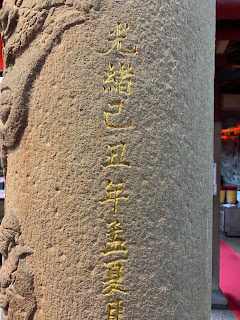 Sandstone pillar from 1880s
Sandstone pillar from 1880s
LUNCH AT WU’S HARBOR CONTEMPORARY CUISINE
With so much walking, we were all looking forward to a nice seaside meal, so we headed to Wu’s Harbor (伍参港), a family-run restaurant specializing in sustainable, seasonal seafood.
As soon as we stepped in, we were all struck by how beautifully everything is, from the décor, to the furniture and the stunning ocean views right outside the windows.
Cosy interior
Balcony
We were first welcomed in by the owner of the restaurant and hostel, Mr. Wu (吳), also known as Cong Ge (聰哥), who explained to us that the restaurant has a strict policy of using local ingredients. The chefs go down to the fish market every day to pick the freshest catch. The menu changes all the time, offering only seasonal seafood. They are also very particular about keeping carbon emissions low, using locally-grown ingredients when possible. Their absolute maximum distance any ingredient will travel to Toucheng is 160 kilometers.
Mr. Wu’s son, Wilson, also gave us a run-through of all the design process for the restaurant, which he himself came up with. I personally loved the explanation for the logo design, which he made. It’s a visual pun! The Chinese characters in the name of the restaurant (伍参港) actually mean “53” So you have the fish in the shape of a five and three as well as three hidden fish elsewhere. (I’m not going to tell you where they are, if you want to know, go to the restaurant and ask Wilson himself).
Logo with three hidden fish
Picking the freshest seafood
Ceramic fish
The marine theme carries on everywhere, with tables and chairs made from driftwood, ship lanterns, ceramic fish tiles on the walls, as well as artworks from local artists. It is a delight.
Drawing showing the now-dry river
But onto the food, which is, after all, what we came here for. We ordered three set meals with fish caught that day, sea ruffe (⽯狗公), which has a lovely springy texture and rosy seabass (紅喉), which is apparently one of the most common and iconic fishes in the area. This was all downed down fast with a variety of rice known as Kaohsiung No. 1, which has a special aroma similar to taro.
Something to look out for is that Mr. Wu told us that they are currently in process of planning a renovation for their top floor to convert it into a café that should open next year!
SURFING AT SUPER GEORGE
Of course, it wouldn’t have been a complete weekend in Toucheng without taking in the waves on a surfboard. For that we headed to Super George (喬治衝浪), a surf shop is located in Shuangshi (雙獅), which is bit further north from the crowded Wai’ao (外澳) beach.
Our instructor was Alex, who made sure that we all had the theory down before going into the ocean. We had a 45-minute class in the surf shop itself, during which Alex explained to us the basic safety measures to not get hurt while surfing as well as the techniques we would be drilling that day. Most of our group had never surfed before, so we went down to the very basics of how to stand on a surfboard. I had gone surfing a few times before, but I found his explanations extremely useful to actually fix all the bad habits I had developed. Then it was out to the beach.
Theory class
Let me tell you, surfing in the coast of Yilan is something unlike anywhere else. Here, you can take in the salty sea breeze, with towering mountains to one side and Turtle Island (⿔ ⼭島) to the other. The wilderness all around you is stunning, and the roar of the ocean peaceful, in a way. Simply breathtaking.
Turtle island in the front
Lush greenery in the back
Before going into the sea I was a bit nervous about the temperature, but the wetsuits they lent us at the surf shop were perfect for keeping us warm in the breezy day, and I was not cold at all. (And this is coming from someone who gets cold really easily). Alex was extremely attentive to all us, giving us tips on how to improve, and by the end of the class, everyone had successfully stood on the board and ridden a few waves! I also really appreciated that he taught me more “advanced” techniques that we didn’t discuss in class, like how to steer the surfboard to the sides, and he gave me exercises to practice zigzagging. All in all, a super fun and fulfilling experience, the three hours we spent here flew by!
DINNER AT HAPPINESS NO. 36
It’s funny that the restaurant is called Happiness (幸福36海鮮餐廳) because that’s exactly the emotion we all felt as soon as the first dishes started arriving at our table. We had built quite the appetite after all the surfing so the lavish dishes that were presented to us were gone in no time! There was everything you could ask for, and the owner assured us it was the freshest catch of the day. From what I’ve read, the owners of the restaurant head out to sea twice a day to ensure that the fish they serve is undoubtedly the freshest. And it’s not just seafood, the restaurant offers quite a variety of meat dishes as well. I’ll let
the pictures speak for themselves.
NIGHT AT TOUCHENG LEISURE FARM
By the time I reached Toucheng Leisure Farm (頭城休閒農場) it was already 9 p.m. and I was worn out and tired. Thankfully, the lovely people in reception volunteered to drive me up to my room in the Shan Hai Building (⼭海樓), which is quite a bit uphill. (The driver said more than 100 steps if I remember correctly).
My bed looked perfect for me to slide right in and turn in for the day. But just as I was contemplating going to sleep, I spotted a sky lantern drifting up right outside my balcony. I eyed my bed with longing but in the end I decided I should go out to explore for juuuust a little bit longer. And it was so worth it. I followed the trail of sky lanterns, which led me to the DIY center, where the last few groups of visitors were lighting up the sky lanterns they had decorated during the previous hour. It was a really beautiful sight, seeing such a large group of people oohing and aahing with every lantern released.
Sky later ready for take-off
After all the lanterns were up in the sky, I took a night stroll around the farm before going back to my room, to take in the silence of the mountains. I spent quite some time at the main pond in the farm, simply sitting down and looking at the reflection of all the lights and petting the local dog, Huangchin (黃⾦). A perfect way to end the day.
A moonlit stroll
Reflections on the pond
Huangchin
TOUR AND DIYS AT TOUCHENG FARM
As I said before, I am not a morning person, but I was more than ready to start off the day early, even if that meant getting up at 7:30 a.m. to get breakfast in time for the farm tour at 8:30 a.m.
Waking up to this
Buffet brekkie
Our tour guide took a group of about 20 of us around the farm, showing us all the different plants that you can find in the lush countryside. He fashioned some into whistles, fishing rods and even single-use arrows. It’s almost as if every single plant could be turned into a toy in his hands! He also showed us some of the herbs they grow in the orchard, including Chinese mesona (仙草), which is a very popular flavoring for drinks and jellies in Taiwan.
Crafting a whistle
Orchard in the mountains
Bug hotel!
We were also delighted to find shameplants (含羞草), which retract their leaves when you touch them. The wild scenery around the farm was dazzling, and it seems we were visiting at just the right time, because all around us we saw dozens of butterflies fluttering all over the place.
Of course, no tour of the farm would be complete without a visit to all their animals: buffalos, goats, turkeys, bunnies, ducks… You name it! Our guide even encouraged us to pick up some greens to feed them and interact with them. It was such a great way to start off the day.
Baby buffalo
Supposedly, I’m beautiful because I managed to pass through these rocks
Tranquil idyll
I couldn’t linger for long though, as I had a full day of DIYs ahead of me. The first one was a workshop on making kumquat vinegar, using fruits collected at the farm. Each group of visitors was handed all the necessary equipment and we were walked through the steps before trying our own hand at it. I made my vinegar in about 30 minutes, but I’m going to have to wait another three months to see if I was actually successful.
The second DIY brought out the fashion designer in me: leaf printing on fabric. Vats of fabric paint were placed around the DIY center, and the instructor showed us how to pick interesting-looking leaves to paint and leave an imprint on either a T-shirt or a tote bag. I decided to stick to one leaf, and one color and focus more on quantity and pattern making. I don’t think my work will be shown on the runway at Taipei fashion week any time soon, but I must say that I think the end result is pretty good! All thanks to mother nature.
Listening attentively
Me and my kumquat vinegar
My printed T-shirt
The morning went by in the blink of an eye amid the tours and the fun DIY activities. So fast in fact, that I was shocked to find myself stamping the last few leaves of my T-shirt pretty much all alone in the DIY area at 1:20 p.m., with almost everybody else having left for lunch! With my stomach rumbling, I rushed to the dining area for another delicious buffet.
Lots of options
My lunch
Bye-bye Huangchin
And with that, I got ready to say goodbye to the mountains and head back to the coast for the final activity of my Toucheng itinerary.
MAP OF TAIWAN WITH SEEDS IN GANGKOU
For the final afternoon activity, I reunited with Nana and Ira at Gangkou Community (港⼝社區) to wrap up our Toucheng trip with a gorgeous and meditative DIY: a topographic map of Taiwan using seeds.
We were guided through the process by Chien Tzu-kui (簡⼦貴), an expert craftsman and passionate seed collector who regularly offers courses on creating objects out of seeds through his workshop, the Futien Seed Art Workshop (福⽥種⼦藝術⼯作坊).
I cannot understate just how much I loved this activity, and how much it has transformed my appreciation of seeds.
From the very first moment, Mr. Chien handed us a bag of about 200 seeds, with a vast variety of shapes, colours and sizes. Then he handed us a map of Taiwan printed on a sheet of cardboard, and a hot glue gun. What ensued was two hours of immersion in the delicate and fascinating world of seeds.
So many possibilities
Nana learning geography
Ira ready to rumble
Mr. Chien gave us some overarching principles on how to create a map that roughly represents Taiwan’s topography, such as making sure that the tallest part on our map matches with Yushan (⽟⼭), the tallest mountain. Then, starting with the larger seeds and working our way to the smaller seeds, we glued and glued bits and bobs to the map to result in a beautiful and unique artwork.
The activity gave me an entire new perspective on just how beautiful and varied seeds are. Even days after, my mind keeps thinking about them. Something that made the whole process particularly pleasant was chatting with Mr. Chien, who is a trove of stories. Not only about seeds and how intertwined they are with the local culture, but about the history of Toucheng, about the traditions of the place and what life is like in this gorgeous corner of Taiwan.
My seedy masterpiece
Proud of our work
FINAL THOUGHTS
These two days in Toucheng have left a deep impression of me, and are turning this corner of Taiwan into one of my favorite escapades from Taipei. There is something about the place that is so charming and understated, that it’s really quite hard to put in words. Perhaps part of my draw to this place is because I grew up in smallish rural communities in the mountains or the coast. Or maybe it’s that no matter where you are from, Toucheng and its people will welcome you with open arms and make you feel at home.

See you soon!
 Stone embankment with no river
Stone embankment with no river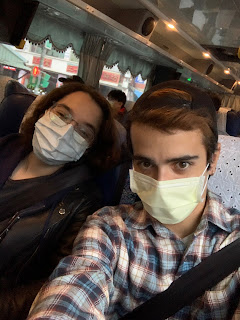





























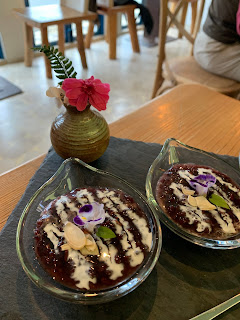




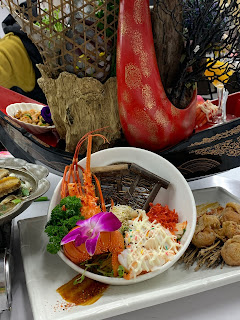













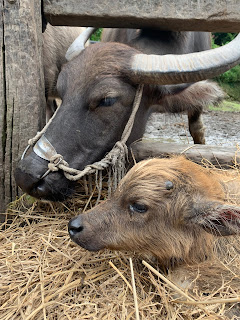














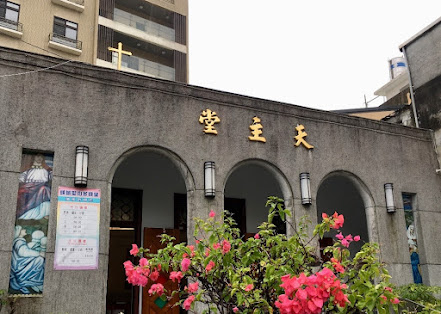

Comments
Post a Comment